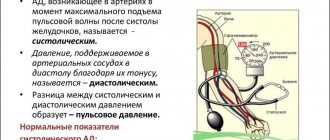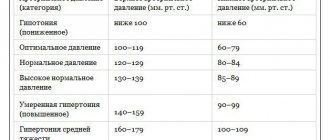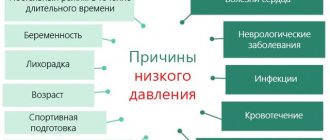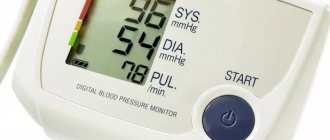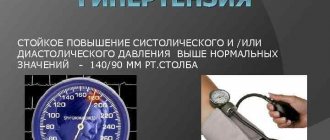During each contraction of the heart, a certain amount of blood is released into the large arteries. This happens under great pressure. The walls of peripheral vessels provide a certain resistance, which prevents the free movement of blood throughout the body. As a result, blood pressure is created in all vessels of the human circulatory system, or it is also called arterial pressure (BP).
The highest levels are recorded in the aorta, the lowest in the vena cava. The level of blood pressure depends on how much blood is pushed out by the myocardium during its contraction, as well as on the elasticity of the vascular walls. The upper pressure (systolic) depends on the amount of blood expelled, and the lower pressure (diastolic) depends on the elasticity of the vascular walls.
Normal values for the upper figure reach 140 mmHg. Art., but they should not fall below 100. If we talk about diastolic blood pressure, then these numbers are from 60 to 90. Blood pressure indicators are also affected by the general condition of the body and the presence of concomitant pathologies. Blood pressure levels are constantly changing. There is a certain relationship between the work of the myocardium, the volume of circulating blood, the lumen of blood vessels and the capacity of the vascular bed. This ratio is controlled by nervous and humoral regulation.
Also, the pressure numbers depend on how much blood returned to the heart through the veins, since the more the atrium and venous sinus stretch, the more powerful the contraction of the heart muscle follows. When recording their own blood pressure readings, people are interested in the question of whether the numbers are normal, especially if accompanying symptoms of pathology appear. The article will look at what a pressure of 110 over 70 means, whether it is considered normal, and, if not, what to do in this condition.
What do the numbers on the blood pressure monitor mean?
When measuring pressure, you need to pay attention to all indicators displayed on the monitor. The first number shows the systolic (upper) pressure, which occurs at the moment of maximum contraction of the heart muscle. The device records the diastolic (lower) pressure during complete relaxation. The third indicator is also important – heart rate.
If you see unusual numbers on the tonometer, you should not panic. They may mean that the device is faulty. However, if normal upper and low lower pressure is demonstrated by another device, there is a reason to consult a doctor for advice. After a comprehensive examination, a specialist will be able to draw a conclusion about why the pressure values deviated from the norm and draw up a scheme for the most effective therapy.
The reference values can be called 120/80 mmHg. Art. with a pulse from 60 to 80. However, for people of different ages, genders, health conditions and lifestyles, they may differ slightly from the ideal, which will not be a deviation from the norm. But only in the case when the pulse difference (the difference between lower and upper blood pressure) is from 20 to 40 units. At a pressure of 120 to 60, the upper value is optimal, but the readings at the time of diastole are underestimated and may indicate health problems. The impressive pulse difference also raises concerns.
No ads 1
Reasons for pressure 125 to 65
Pressure 125 to 65 mm Hg. depending on age, it can be considered normal or indicate the presence of a disease or health problems.
The number 125 is a systolic indicator, reflecting the blood tension of the walls of blood vessels during heart activity. The numbers 65 characterize the diastolic value, indicating the state of the vessels at the moment of muscle relaxation.
Blood pressure is affected by:
- age;
- weight;
- measurement time.
If the obtained numbers differ significantly from the norms established by doctors, and the person notes symptoms of malaise, this indicates the presence of malfunctions in the body.
An increase or decrease in blood pressure may be due to accompanying factors or to the device. The measurement needs to be repeated. It must be remembered that the obtained values must be compared with age-appropriate norms. For a young person, a blood pressure of 125 over 65 may be normal. The doctor may look for a low diastolic value.
If there is a downward trend in the lower reading, you need to undergo an examination. For older people, both values will be low.
The reasons for the low value may be:
- heart failure;
- improper production of hormones;
- infectious diseases;
- kidney disease;
- stomach ulcer;
- decreased hemoglobin levels;
- significant blood loss;
- decreased fluid in the body;
- congenital hypotension.
The reasons may lie in human adaptation to new environmental conditions. Stress, nervousness, shock can lead to either a decrease in blood pressure or an increase in blood pressure. The reason for a decrease in blood pressure may be the incorrect or untimely use of drugs to reduce values.
If a cause of low blood pressure is identified that cannot be eliminated on your own, the doctor will prescribe treatment.
Blood pressure 125 over 65 - is this normal or not?
Your doctor can tell you what pressure is normal. It is believed that normal blood pressure is represented by the following indicators:
- 120 mmHg systolic or top value;
- 80 mmHg diastolic or bottom number;
- pulse is around 80-90 beats per minute.
Blood pressure of 125 over 65 can be considered normal if the person’s age is younger than average, there are no pathological diseases, and the condition is satisfactory. With such aspects, you do not need to do anything.
The indicator depends on age. It has been established that blood pressure increases with age. In older people, a value of 125 over 65 may be a signal of the development of the disease. There is a list of normal indicators depending on age, it is a guideline for considering at home what the number on the tonometer screen means.
In accordance with these standards, we can conclude that a value of 125 over 65 means relatively normal blood pressure for a certain age.
For what age is a blood pressure of 125 over 65 considered normal?
There is a norm for blood pressure indicators established to determine the boundaries when taking measurements.
The dependence of normal blood pressure values on age was revealed:
- for a teenager, the upper value should be around 100-120 mmHg, the lower 70-80;
- for middle age, systolic blood pressure should be 120-140 mm Hg, diastolic 70-90 mm Hg;
- in the elderly the indicator is increased: the upper one is around 150 mm Hg, the lower one is 90 mm Hg.
Whether blood pressure is 125 over 65 is normal or the indicator is too low can be known based on accepted standards depending on age.
If we consider the age of the person who was measured, then:
- in adolescents, the upper level can be considered elevated, the lower level close to normal;
- for middle age, blood pressure with such figures means close to normal;
- in the elderly, this value may be a sign of low blood pressure or hypotension.
A value of 125 to 65 in the elderly means excessive relaxation of the vascular walls, as a result of which they cannot cope with the load.
Blood pressure 125 over 65 in a teenager
If a teenager's blood pressure is 125 over 65, there is no point in drawing hasty conclusions. When compared with the recognized normal value, the upper indicator is increased, the lower one corresponds to the norm. There is no need to do anything to reduce the numbers reflected on the tonometer without a diagnosis from a doctor.
The doctor must say whether an increased systolic value indicates the presence of a disease. Measuring in the morning may give an increased number. A nervous situation, excessive physical activity, and fatigue could affect the performance.
Blood pressure values should be monitored for some time, measurements should be taken at the same time, the teenager’s condition should be noted, and all symptoms should be recorded. The upper value is 125 mmHg. may be the norm for an individual child depending on his age or workload.
In parallel with observation, it is imperative to undergo examination at a medical institution in order to prevent the development of a pathological disease.
Blood pressure 125 over 65 during pregnancy
Lowering the lower blood pressure level to 65 mm Hg. during pregnancy may mean a disturbance in the blood supply to the fetus. This problem means:
- oxygen starvation;
- the appearance of developmental defects;
- placental insufficiency.
As the period increases, an increase in blood pressure is observed. The main differences occur in the first trimester. The indicators are monitored by doctors. If the values decrease, the doctor will prescribe medications to help the pregnant woman.
Taking medications during pregnancy is not advisable. Normal indicators should be achieved by proper organization of the daily routine and nutrition, and folk remedies.
Additional symptoms
Low diastolic pressure against a background of normal systolic pressure is usually accompanied by characteristic symptoms:
- A man has a headache.
- Your heart rate slows or your pulse becomes irregular.
- Dizziness occurs when you suddenly turn your head or come out of the dark into the light.
- Fainting, starting with darkening of the eyes, is possible.
- Memory deteriorates.
- Activity decreases, fatigue occurs even at rest.
- The patient becomes irritable, periods of apathy are replaced by aggression.
With both hypertension and hypotension, a person begins to react sharply to the vagaries of the weather with increased symptoms
Symptoms of hypotension and the danger of the condition
Patients seek medical help with the following complaints:
- the appearance of drowsiness and loss of strength;
- cephalgia;
- general weakness;
- dizziness;
- decreased performance;
- discomfort in the heart area;
- nausea, sometimes vomiting.
A headache with hypotension differs from the one that occurs against the background of elevated blood pressure numbers, which allows you to differentiate your own condition if you don’t have a tonometer at hand. With hypertension, the pain seems to compress the head, and pulsation occurs in the temples and crown. Against the background of hypotension, the pain is aching in nature and often appears in the back of the head. The danger of hypotension lies in the fact that blood flow slows down, that is, the brain and internal organs do not receive the required amount of blood, and therefore nutrients and oxygen.
Reasons for violation
If the pressure is 120 to 60 mmHg. Art. when the pulse is 50, it is recorded for the first time or bothers a person only occasionally; it can be caused by physiological factors and can be easily corrected. Among the main causes of the condition are:
What does pressure 135 over 65 mean?
- hypothermia;
- dehydration;
- stress;
- starvation;
- intense physical activity, for example, in the gym (pulse and blood pressure drop during rest - the heart regains strength after overexertion);
- pregnancy (during the period of bearing a child, especially in the 1st trimester, blood pressure can fluctuate in the range of 20 mm Hg about the norm and this does not indicate abnormalities in the functioning of the body).
No ads 2
Pressure 125 over 60 or 120 over 60 mmHg. Art., recorded regularly, can be a symptom of serious pathologies, including the following:
- endocrine diseases (adrenal diseases, diabetes mellitus);
- cardiac pathologies (bradycardia, heart failure, congenital aortic valve defects, infectious myocarditis, coronary artery disease, recent heart attack, etc.);
- atherosclerosis;
- kidney diseases;
- malignant tumors;
- acute poisoning;
- pulmonary embolism;
- profuse blood loss due to extensive trauma.
Low diastolic pressure may be accompanied by increased heart rate. Thus, a pulse of 90 is a compensatory reaction to hypoxia and decreased blood circulation.
If the lower pressure drops to 40 mm Hg. Art. Emergency assistance should be sought as this condition may indicate a life-threatening condition requiring urgent hospitalization. Trying to raise this pressure on your own with pills or a cup of strong coffee is not recommended.
Important! Some medications can also reduce diastolic pressure. If the phenomenon occurs during the treatment of a chronic or infectious disease, this must be reported to the doctor, who will adjust the dose of the medication or select an alternative that does not provoke blood pressure fluctuations.
If unpleasant symptoms associated with changes in blood pressure appear, you need to visit your general practitioner, who will give you directions for examination.
Pathology or normal?
If we consider the average statistical indicators of the norm, then the pressure of 110 to 70 corresponds to the acceptable limits. However, each person has his own “working” pressure, at which he feels most optimal. These numbers are purely individual, therefore, when analyzing indicators of 110 to 70, it is necessary to take into account the “working” level of blood pressure. You should also rely on the presence of concomitant pathologies and the age of the patient.
It should also be said that when recording indicators on a tonometer, it is advisable to write them down in a notebook, especially if the numbers tend to change significantly during the day. Moreover, experts record the pressure level without rounding. For example, like this:
- 108 by 74;
- 101 to 66;
- 107 to 67;
- 126 by 66;
- 111 to 65;
- 109 by 70, etc.
Important! In medical documentation, the upper indicator is separated from the lower one by a “/”. For example, 114/75.
Puberty
If we talk about boys and girls from 13 to 16 years old, then the indicator 110 to 70 fully corresponds to normal pressure. The teenage period is quite often accompanied by deviations in blood pressure, both upward and downward, as the body matures and the hormonal balance changes.
20-40 years
For this group of patients, the indicators are also considered normal, however, “working” pressure and fluctuations in numbers throughout the day should be taken into account. For example, if in the morning and evening the tonometer shows 130 over 90 and a person feels great, and during the day the readings appear at 100 over 68, which are accompanied by headache and dizziness, rapid heartbeat, you can safely think about hypotension.
Hypotension is a decrease in blood pressure. This condition can be physiological and pathological. The physiological type does not require medical intervention, since it can arise as a result of physical exertion, emotional shock, and experiences. After some time, the indicators return to normal on their own. The pathological type has a specific cause in the form of a concomitant disease, manifests itself with a clear clinical picture and requires treatment.
During pregnancy
While carrying a baby, the mother's blood pressure can either increase or decrease. A decrease in blood pressure during the first 12-14 weeks of pregnancy is especially dangerous; it usually occurs against the background of toxicosis, accompanied by frequent vomiting. For thin women and expectant mothers of average build, a pressure of 110 over 70 is absolutely normal. Usually it is kept within the range of 120-117 to 75-70 throughout the entire gestation period (provided that the mother is in optimal health). If the woman is large and obese, 110 over 70 may be a symptom of hypotension, since in such patients the “working” blood pressure is usually slightly higher.
Aged people
Elderly patients have slightly different normal indicators, because age-related changes occur in the vessels and myocardium. For older people, values of 135-140 (upper pressure), 85-90 (lower pressure) are considered normal. Accordingly, 110 over 70 will be a symptom of hypotension for them. With a sustained decrease in blood pressure, the condition is called arterial hypotension.
It should be taken into account that blood pressure indicators are affected by physical activity, hormonal changes (for example, in this case we are talking about menopause in women), stressful situations, conversations during blood pressure measurements, alcohol abuse, number of meals, smoking, amount of salt in consumed products. For example, if a person is used to eating fairly salty foods, and then suddenly decides to limit the amount of salt, the pressure can really drop.
Also, a decrease in blood pressure levels occurs while taking antihypertensive drugs, especially if they are selected not by specialists in the field of cardiology or therapy, but by the patient himself.
Diagnostic methods
The reason why low blood pressure decreases can be determined through comprehensive diagnostics. The list of survey activities includes:
- General blood analysis. Biochemical research allows us to identify anemia, which often causes low blood pressure, especially in young women.
- ECG. An echocardiogram gives a complete picture of the structure of the heart and whether its functioning is normal. In this way, it is possible to determine heart valve disorders and other severe pathologies in a person of any gender and age.
- X-ray. Through X-ray examination, it is possible to identify a number of diseases that can lead to fluctuations in blood pressure, accompanied by an increase or decrease in heart rate.
Treatment
What to do if the examination reveals a serious pathology that requires treatment? In this case, you should not adjust blood pressure, but focus on solving the primary problem. Only by eliminating the reason why the pressure dropped from the usual 120 to 80 to 120 to 65 or 60 mm Hg. Art. you can improve your well-being.
With a pressure of 120–122 at 60–66 mm Hg. Art. alcohol, namely red wine, in small doses is not only allowed, but recommended by doctors
If no concomitant diseases are found, then you can stick to home methods to solve the problem. Namely:
- When your head starts to hurt due to decreased blood pressure, you can take a tablet that has an antispasmodic effect, for example, Spazmalgon or Citramon, which slightly increases blood pressure.
- Traditional medicine recipes, previously agreed upon with your doctor, will help strengthen blood vessels and normalize the heart rate: decoctions of elecampane, yarrow, infusions of Chinese lemongrass, tinctures of ginseng and eleutherococcus. The course of treatment is at least 40 days.
- It is important to include sports in your schedule: jogging in the nearest park, going to the pool or doing yoga. If you have no free time at all, you can limit yourself to morning exercises.
- Problems with blood pressure may be associated with disrupted sleep patterns. In this case, it is worth eliminating shift work or night work, which prevents you from fully resting at night for at least 8 hours.
- The most dangerous habit that negatively affects blood pressure is smoking. Nicotine reduces the volume of the lungs, causing the heart to work at an increased pace, and clogs the blood vessels and liver cells. By giving up this bad habit, you can quickly get rid of blood pressure fluctuations without the use of medications.
- Nutrition plays a leading role in normalizing blood pressure. It is better to opt for 5 meals a day in small portions. Food should be varied, rich in healthy vitamins and microelements.
Advice! The Mediterranean diet, consisting mainly of sea fish, vegetables, and olive oil, has the most beneficial effect on the body as a whole and the state of the cardiovascular system as a whole. For snacks, you should choose nuts, fruits, dried fruits, rather than empty carbohydrates.
